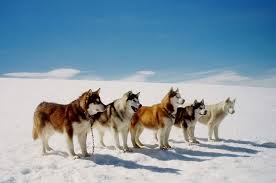The Siberian Husky (Russian: Сибирский хаски, Sibirskiy haski, "Siberian husky") is a medium-size, dense-coat working dog breed that originated in north-eastern Siberia. The breed belongs to the Spitz genetic family. It is recognisable by its thickly furred double coat,sickle tail, erect triangular ears, and distinctive markings.
Huskies are an active, energetic, and resilient breed whose ancestors came from the extremely cold and harsh environment of the Siberian Arctic. Siberian Huskies were bred by the Chukchi of Northeastern Asia to pull heavy loads long distances through difficult conditions. The dogs were imported into Alaska during the Nome Gold Rush and later spread into the United States and Canada. They were initially sent to Alaska and Canada as sled dogs but rapidly acquired the status of family pets and show dogs.




Size
The breed standard indicates that the males of the breed are ideally between 21 and 23.5 inches (53 and 60 cm) tall at the withers and weighing between 45 and 60 pounds (20 and 27 kg). Females are smaller, growing to between 20 to 22 inches (51 to 56 cm) tall at the withers and weighing between 35 to 55 pounds (16 to 25 kg).[6]
[edit]Behavior
The Siberian Husky has been described as a behavioral representative of the domestic dog's forebear, the wolf, exhibiting a wide range of its ancestors' behavior.[9] They are known to howl rather than bark.[10] If the dog is well trained it can make a great family pet. The frequency of kenneled Siberian Huskies, especially for racing purposes, is rather high, as attributed through the history of the breed in North America. They are affectionate with people, but independent. A fifteen-minute daily obedience training class will serve well for Siberian Huskies.[11] Siberians need consistent training and do well with a positive reinforcement training program. They rank 45th in Stanley Coren's The Intelligence of Dogs, being of average working/obedience intelligence. They tend to run because they were at first bred to be sled dogs. Owners are advised to exercise caution when letting their Siberian Husky off the leash as the dog could be miles away before looking around and realizing their owner is nowhere in sight. They are excellent "escape artists" as well and have been known to climb chain-link fences and find other ways of escaping a confined area. They also get bored easily, so playing with toys or throwing the ball at least once a day is essential. Failure to give them the attention or proper exercise they need can result in unwanted behavior, such as excessive howling, marking, chewing on furniture, or crying.[12]
Siberian Huskies are highly intelligent, which allows them to excel in obedience trials, though many clubs would like to keep the Husky's instinct by doing sled-racing.[13] However, because of their intelligence, they can easily become bored and may stop listening to commands. Many dog trainers usually attempt to avoid this behavior by keeping them busy with new activities. Also due in part to their intelligence, Huskies tend to be very observant on the actions of people around them and have been known to mimic common household activities such as turning on lights with their paws and opening doors with their canines. Some undesirable behaviors they can exhibit include opening refrigerators (and eating the food inside), climbing fences or digging tunnels in the backyard to escape.[14] These behaviors can be prevented if the dog is given enough activity to occupy it. Huskies require both mental and physical stimulation for optimum health.
PREPARED BY:
Mr.Kazu Ichiru
kazu@prosperjp.com
+81-50-5539-9816
NEED CARS FOR YOUR FAMILY ?YOU CAN CALL OR E MAIL ME.
IM SO PROUD IF IM A BRIDGE TO GET YOUR DREAM CAR FOR YOUR
FAMILY.
PROSPER CO.LTD JAPAN
